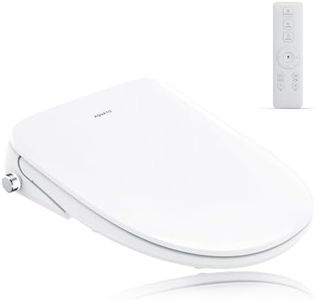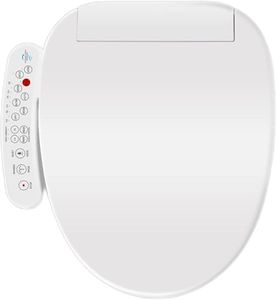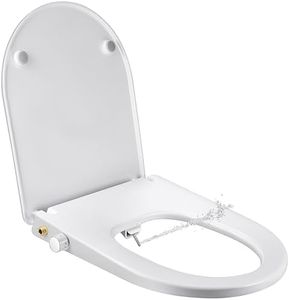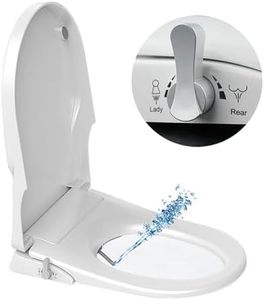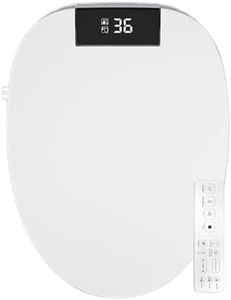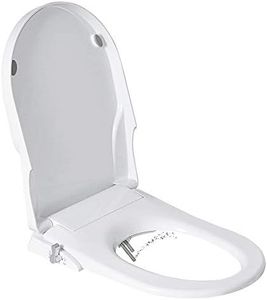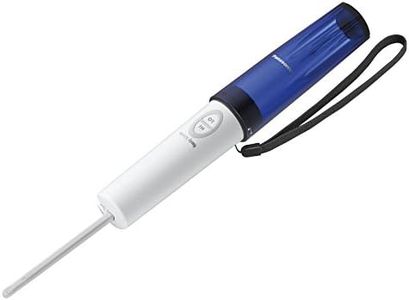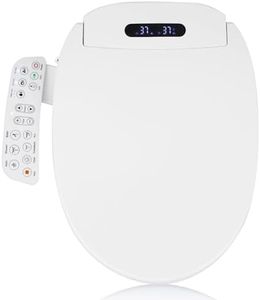We Use CookiesWe use cookies to enhance the security, performance,
functionality and for analytical and promotional activities. By continuing to browse this site you
are agreeing to our privacy policy
10 Best Japanese Toilet
From leading brands and best sellers available on the web.Buying Guide for the Best Japanese Toilet
Choosing a Japanese toilet, also known as a bidet toilet or smart toilet, can greatly enhance daily comfort and hygiene in your bathroom. Japanese toilets come with advanced features focused on cleanliness, convenience, and accessibility. To make the right choice, start by thinking about your priorities: Are you seeking luxury, better hygiene, easier cleaning, or improved accessibility for yourself or family members? Understanding your needs will help you focus on the features that matter most to your household. Consider your bathroom setup too: some models require electrical outlets, extra plumbing, or a certain amount of space. Evaluate key specs to find the best match for your preferences and lifestyle.Wash FunctionsWash functions are the core of the Japanese toilet experience, offering options like rear wash, front wash (for feminine hygiene), adjustable water pressure, and oscillation. These functions use a built-in nozzle to clean with water, providing greater hygiene and comfort compared to toilet paper alone. Simpler models may just offer a standard rear wash, while advanced ones include multiple modes with customizable settings. If you value personalization and maximum hygiene, seek models with adjustable pressure, temperature, and nozzle position. If you prefer simplicity, a basic wash function will suffice.
Heated SeatA heated seat keeps the toilet seat warm during use, which can be especially comforting in colder climates or during winter months. Look for models with seat temperature control if you want to adjust it to your liking. Low-end options may offer standard heating, while premium ones provide more control and even zone heating. For users who prioritize comfort or who live in cold areas, this feature can be very desirable. If this is less important, a non-heated or basic heated seat will suffice.
Dryer FunctionThe dryer function uses a gentle stream of warm air to dry you after washing, reducing or even eliminating the need for toilet paper. Dryer strength and temperature can sometimes be adjusted, and higher-end toilets have faster drying times with customizable warmth. This is particularly useful for people with mobility challenges or for those seeking maximum convenience. To decide, think about whether hands-free drying feels important in your daily routine.
Nozzle SterilizationNozzle sterilization helps ensure the bidet remains hygienic by automatically cleaning the nozzles with water or antibacterial agents after each use. Basic models typically offer a self-cleaning rinse, while advanced versions use UV light or electrolyzed water for extra sterilization. For those with strict hygiene concerns, advanced sterilizing options provide greater peace of mind. For others, a basic rinse could be enough.
DeodorizerA built-in deodorizer neutralizes bathroom odors during and after use. Some use filters or fans to minimize smells, and higher-spec units offer more effective or automatic deodorizing functions. If you have a small, enclosed bathroom or want to keep your space fresher, a deodorizer is worthwhile. In a large, well-ventilated bathroom, you might not need this feature as much.
Auto Lid and FlushingAuto lid and flushing features add a touch of automation and hygiene. The toilet lid opens and closes automatically when someone approaches or leaves, and some models also flush automatically. Advanced systems are touchless for maximum convenience and cleanliness. These are useful for people who want a hands-free experience, have accessibility needs, or simply value the convenience.
Remote Control and PresetsMany Japanese toilets come with remote controls or wall-mounted panels for adjusting settings like wash, dry, and seat temperature. Some offer memory presets so different users can save preferred settings. Simpler controls are easier for less tech-savvy users, while remotes with multiple options are ideal for families with varied preferences. Think about your household and how comfortable everyone will be using the controls.
Installation and CompatibilityInstallation requirements are critical for Japanese toilets. Some are complete toilets, while others are just seats that attach to an existing toilet bowl. Consider the type that fits your current bathroom setup, the need for electrical outlets, and whether plumbing adjustments are required. If you're replacing an old toilet or remodeling, a full integrated model may be best. If you want an upgrade without major changes, a bidet seat is often easier and quicker to install.
